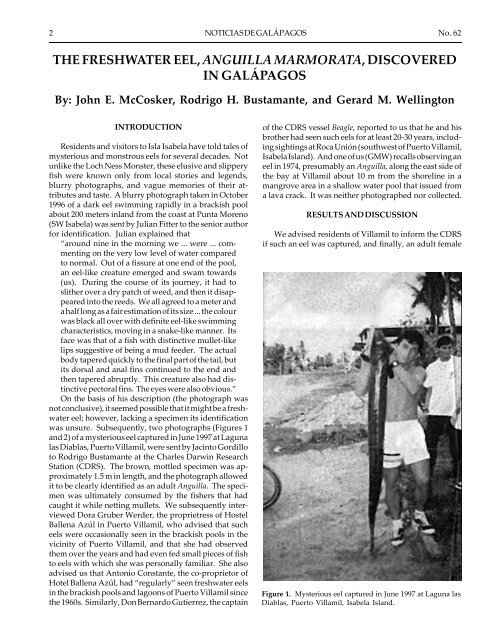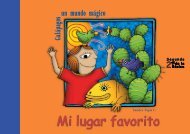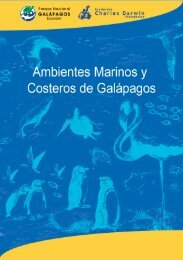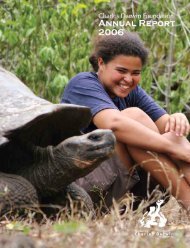The Freshwater Eel, Anguilla Marmorata, discovered in Galapagos
The Freshwater Eel, Anguilla Marmorata, discovered in Galapagos
The Freshwater Eel, Anguilla Marmorata, discovered in Galapagos
You also want an ePaper? Increase the reach of your titles
YUMPU automatically turns print PDFs into web optimized ePapers that Google loves.
2 NOTICIAS DE GALÁPAGOS No. 62<br />
THE FRESHWATER EEL, ANGUILLA MARMORATA, DISCOVERED<br />
IN GALÁPAGOS<br />
By: John E. McCosker, Rodrigo H. Bustamante, and Gerard M. Well<strong>in</strong>gton<br />
INTRODUCTION<br />
Residents and visitors to Isla Isabela have told tales of<br />
mysterious and monstrous eels for several decades. Not<br />
unlike the Loch Ness Monster, these elusive and slippery<br />
fish were known only from local stories and legends,<br />
blurry photographs, and vague memories of their attributes<br />
and taste. A blurry photograph taken <strong>in</strong> October<br />
1996 of a dark eel swimm<strong>in</strong>g rapidly <strong>in</strong> a brackish pool<br />
about 200 meters <strong>in</strong>land from the coast at Punta Moreno<br />
(SW Isabela) was sent by Julian Fitter to the senior author<br />
for identification. Julian expla<strong>in</strong>ed that<br />
“around n<strong>in</strong>e <strong>in</strong> the morn<strong>in</strong>g we ... were ... comment<strong>in</strong>g<br />
on the very low level of water compared<br />
to normal. Out of a fissure at one end of the pool,<br />
an eel-like creature emerged and swam towards<br />
(us). Dur<strong>in</strong>g the course of its journey, it had to<br />
slither over a dry patch of weed, and then it disappeared<br />
<strong>in</strong>to the reeds. We all agreed to a meter and<br />
a half long as a fair estimation of its size ... the colour<br />
was black all over with def<strong>in</strong>ite eel-like swimm<strong>in</strong>g<br />
characteristics, mov<strong>in</strong>g <strong>in</strong> a snake-like manner. Its<br />
face was that of a fish with dist<strong>in</strong>ctive mullet-like<br />
lips suggestive of be<strong>in</strong>g a mud feeder. <strong>The</strong> actual<br />
body tapered quickly to the f<strong>in</strong>al part of the tail, but<br />
its dorsal and anal f<strong>in</strong>s cont<strong>in</strong>ued to the end and<br />
then tapered abruptly. This creature also had dist<strong>in</strong>ctive<br />
pectoral f<strong>in</strong>s. <strong>The</strong> eyes were also obvious.”<br />
On the basis of his description (the photograph was<br />
not conclusive), it seemed possible that it might be a freshwater<br />
eel; however, lack<strong>in</strong>g a specimen its identification<br />
was unsure. Subsequently, two photographs (Figures 1<br />
and 2) of a mysterious eel captured <strong>in</strong> June 1997 at Laguna<br />
las Diablas, Puerto Villamil, were sent by Jac<strong>in</strong>to Gordillo<br />
to Rodrigo Bustamante at the Charles Darw<strong>in</strong> Research<br />
Station (CDRS). <strong>The</strong> brown, mottled specimen was approximately<br />
1.5 m <strong>in</strong> length, and the photograph allowed<br />
it to be clearly identified as an adult <strong>Anguilla</strong>. <strong>The</strong> specimen<br />
was ultimately consumed by the fishers that had<br />
caught it while nett<strong>in</strong>g mullets. We subsequently <strong>in</strong>terviewed<br />
Dora Gruber Werder, the proprietress of Hostel<br />
Ballena Azúl <strong>in</strong> Puerto Villamil, who advised that such<br />
eels were occasionally seen <strong>in</strong> the brackish pools <strong>in</strong> the<br />
vic<strong>in</strong>ity of Puerto Villamil, and that she had observed<br />
them over the years and had even fed small pieces of fish<br />
to eels with which she was personally familiar. She also<br />
advised us that Antonio Constante, the co-proprietor of<br />
Hotel Ballena Azúl, had “regularly” seen freshwater eels<br />
<strong>in</strong> the brackish pools and lagoons of Puerto Villamil s<strong>in</strong>ce<br />
the 1960s. Similarly, Don Bernardo Gutierrez, the capta<strong>in</strong><br />
of the CDRS vessel Beagle, reported to us that he and his<br />
brother had seen such eels for at least 20-30 years, <strong>in</strong>clud<strong>in</strong>g<br />
sight<strong>in</strong>gs at Roca Unión (southwest of Puerto Villamil,<br />
Isabela Island). And one of us (GMW) recalls observ<strong>in</strong>g an<br />
eel <strong>in</strong> 1974, presumably an <strong>Anguilla</strong>, along the east side of<br />
the bay at Villamil about 10 m from the shorel<strong>in</strong>e <strong>in</strong> a<br />
mangrove area <strong>in</strong> a shallow water pool that issued from<br />
a lava crack. It was neither photographed nor collected.<br />
RESULTS AND DISCUSSION<br />
We advised residents of Villamil to <strong>in</strong>form the CDRS<br />
if such an eel was captured, and f<strong>in</strong>ally, an adult female<br />
Figure 1. Mysterious eel captured <strong>in</strong> June 1997 at Laguna las<br />
Diablas, Puerto Villamil, Isabela Island.
December 2003 NOTICIAS DE GALÁPAGOS 3<br />
was captured on 15 October 1998 by Kleber Garcia and<br />
Jerson Moreno, the former a CDRS volunteer native to<br />
Galápagos, and the latter a resident CDRS scientist on<br />
Isabela. <strong>The</strong>y mentioned that such eels had been seen<br />
around Villamil. It was captured at the brackish lagoon<br />
known as “Poza de la <strong>Anguilla</strong>.” <strong>The</strong> lagoon was small,<br />
5 m x 2 m x 2 m deep, but associated with a large system<br />
of <strong>in</strong>terconnected lava tubes, s<strong>in</strong>k holes and cracks that<br />
dra<strong>in</strong> water from the highlands. As a result of the significant<br />
1997/1998 El Niño event at that time, the water was<br />
much fresher and more abundant than normal. <strong>The</strong> water<br />
temperature was 22-24 o C, about 2-3 o cooler than the<br />
coastal seawater, and the sal<strong>in</strong>ity ranged from nearly<br />
fresh dur<strong>in</strong>g that El Niño event at 5-8 ppm (after a heavy<br />
ra<strong>in</strong>fall) to 16-18 ppm dur<strong>in</strong>g the La Niña periods. Lack<strong>in</strong>g<br />
adequate formaldehyde, the specimen deteriorated<br />
somewhat, but it was ultimately preserved and is now<br />
be<strong>in</strong>g studied at the California Academy of Sciences (CAS)<br />
<strong>in</strong> San Francisco, CA, USA.<br />
With specimen <strong>in</strong> hand, we are now confident that “El<br />
Monstruo de Villamil” is a species of <strong>Anguilla</strong>, which we<br />
Figure 2. Same eel as Figure 1, captured while nett<strong>in</strong>g mullet<br />
<strong>in</strong> the lagoon near town.<br />
cautiously (our caution is expla<strong>in</strong>ed below) identify as A.<br />
marmorata Quoy and Gaimard, the Giant mottled freshwater<br />
eel (Figure 3). <strong>The</strong> accepted common name for this<br />
species <strong>in</strong> Spanish is “<strong>Anguilla</strong> moteada gigante” (Smith<br />
1999). <strong>The</strong> measurements (<strong>in</strong> mm) and counts of the<br />
Galápagos specimen are as follows: total length 863; head<br />
113; head + trunk 378; tail 485; caudal f<strong>in</strong> extension 23;<br />
dorsal f<strong>in</strong> orig<strong>in</strong> 288; pectoral f<strong>in</strong> 45.5; pectoral f<strong>in</strong> base<br />
18.3; jaw 30; lower jaw extension 2.3; snout 22; eye diameter<br />
9.4; gill open<strong>in</strong>g 19; <strong>in</strong>terorbital width 23.3; isthmus<br />
~41; body depth at gill open<strong>in</strong>g ~50; body width at gill<br />
open<strong>in</strong>g ~50; total vertebrae 109; predorsal vertebrae 28;<br />
preanal vertebra 39. It possesses large ovaries with develop<strong>in</strong>g<br />
but immature ova. <strong>The</strong> coloration (<strong>in</strong> ethanol<br />
preservative) of the specimen’s ch<strong>in</strong>, cheeks, throat and<br />
ventral surface is yellowish tan, overla<strong>in</strong> with a darker<br />
mottl<strong>in</strong>g at mid-body, becom<strong>in</strong>g entirely dark along the<br />
dorsal surface and the posterior third of the tail region.<br />
All of its f<strong>in</strong>s are dark.<br />
<strong>The</strong> discovery of an <strong>Anguilla</strong> <strong>in</strong> Galápagos represents<br />
a family (Anguillidae) previously unrecorded from<br />
Galápagos or elsewhere <strong>in</strong> the eastern Pacific. It is clearly<br />
not an Atlantic species (the two Atlantic species are dist<strong>in</strong>ctly<br />
different), and its likely provenance is the central<br />
Pacific. <strong>Anguilla</strong> marmorata is widely distributed <strong>in</strong> the<br />
tropical Indo-west Pacific from east Africa to the Society<br />
Islands and north to southern Japan (Tsukamoto and<br />
Aoyama 1998). It reaches a length of 2 m and a maximum<br />
weight of 21 kg (Castle 1984), mak<strong>in</strong>g it one of the larger<br />
species with<strong>in</strong> the genus. <strong>Freshwater</strong> eels are slow-grow<strong>in</strong>g<br />
and long-lived. <strong>The</strong> European A. anguilla can reach an<br />
age of 50 years or more (Moriarty 1978) and the New<br />
Zealand Longf<strong>in</strong> eel (A. dieffenbachii) is estimated to reach<br />
at least 60 years (Burnet 1969). <strong>The</strong> maximum age of A.<br />
marmorata has not been established. Adult A. marmorata <strong>in</strong><br />
the central Pacific are known to <strong>in</strong>habit deep, rocky estuar<strong>in</strong>e<br />
and freshwater pools where they actively feed,<br />
usually at night, on a wide range of prey, <strong>in</strong>clud<strong>in</strong>g crabs,<br />
frogs and fish. <strong>Freshwater</strong> eels differ from all other true<br />
eels <strong>in</strong> a comb<strong>in</strong>ation of characters <strong>in</strong>clud<strong>in</strong>g the project<strong>in</strong>g<br />
lower jaw, large pectoral f<strong>in</strong>s, bands of m<strong>in</strong>ute teeth,<br />
and the presence of small scales on the body.<br />
<strong>The</strong> approximately 15-16 species of freshwater eels,<br />
family Anguillidae, were heretofore known only from<br />
the tropical and temperate Atlantic, central and western<br />
Pacific and Indian oceans (Smith 1989, 1999, Tsukamoto<br />
and Aoyama 1998, Arai et al. 2001). <strong>The</strong>y are catadromous,<br />
whereby the juveniles and adults live <strong>in</strong> estuaries<br />
and freshwater and the semelparous adults return to<br />
oceanic gyres to spawn and die. <strong>The</strong>ir larvae, called<br />
leptocephali, return via surface currents to the estuaries,<br />
transform <strong>in</strong>to juvenile elvers, and then enter freshwater<br />
habitats as adults (Moriarty 1978). Absent the deep,<br />
sal<strong>in</strong>e gyres necessary to anguillid reproduction <strong>in</strong> the<br />
eastern Pacific Ocean, it has long been assumed that<br />
anguillid eels do not ma<strong>in</strong>ta<strong>in</strong> reproduc<strong>in</strong>g populations<br />
<strong>in</strong> the eastern Pacific or its outly<strong>in</strong>g islands (Smith 1989,
4 NOTICIAS DE GALÁPAGOS No. 62<br />
Figure 3. <strong>Anguilla</strong> marmorata Quoy and Gaimard, the Giant mottled freshwater eel.<br />
Williamson and Tabeta 1991). Adult and juvenile specimens<br />
of <strong>Anguilla</strong> spp. previously found <strong>in</strong> western North<br />
America were the result of accidental or <strong>in</strong>tentional release<br />
of larvae <strong>in</strong> order to harvest the grown <strong>in</strong>dividuals<br />
(McCosker 1989). We f<strong>in</strong>d it highly unlikely that the<br />
Galápagos specimens would have been released by humans,<br />
particularly because they have been observed long<br />
before opportunities such as airfreight transportation<br />
would have allowed the transport and release of juveniles<br />
by humans to Galápagos. We assume that the<br />
presence of <strong>Anguilla</strong> <strong>in</strong> Galápagos represents the sporadic<br />
arrival of their larvae and fortuitous events that allowed<br />
their settlement at SW Isabela. Recent studies have demonstrated<br />
that extreme El Niño events can <strong>in</strong>crease the<br />
likelihood of Indo-Pacific larval transport to Galápagos<br />
(Richmond 1990, Grove 1989, Glynn and Ault 2000). Other<br />
recent studies <strong>in</strong>dicate that spawn<strong>in</strong>g sites for A. marmorata<br />
may occur with<strong>in</strong> the North Equatorial Current west of<br />
the Marianas Islands and a southern population may be<br />
associated with the South Equatorial Current (Arai et al.<br />
2001). Dur<strong>in</strong>g El Niño/Southern Oscillation (ENSO) events,<br />
it is likely that larvae could be transported <strong>in</strong> an easterly<br />
direction either by the Northern or the Southern Equatorial<br />
Counter Currents (Wyrtki 1967, 1985, Delcroix et al.<br />
1987, Johnson and McPhaden 2000). Arai et al. (2002)<br />
found the average duration of the leptocephalus stage of<br />
A. marmorata to be 116-132 days and the age at recruitment<br />
to range between 145-159 days. Accelerated North Equatorial<br />
Counter Current flow between the L<strong>in</strong>e Islands and<br />
the Galápagos dur<strong>in</strong>g ENSO events can reduce the transit<br />
time from 160 to 50-80 days (Richmond 1990, Grigg<br />
and Hey 1992), easily allow<strong>in</strong>g the surface transport of<br />
A. marmorata larvae. As well, the deeper-flow<strong>in</strong>g (50-300<br />
m) Equatorial Undercurrent (Wyrtki 1967) could provide<br />
transport from the L<strong>in</strong>e Islands to Galápagos with<strong>in</strong><br />
the larval duration of A. marmorata. <strong>The</strong> precise orig<strong>in</strong> of<br />
the Galápagos <strong>in</strong>dividuals will best be identified with<br />
the aid of genetic markers.<br />
An alternative hypothesis would favor a vicariance<br />
explanation, such that the Galápagos <strong>Anguilla</strong> were derived<br />
from a pan-Tethyan, western Atlantic species that<br />
was distributed across the shallow Central American<br />
seaway. Such an explanation suffices to expla<strong>in</strong> the curious<br />
presence of the Blackspot porgy (Archosargus<br />
pourtalesii), a Galápagos endemic that lacks a Pacific congener<br />
but whose closest relatives are from the Caribbean<br />
(McCosker and Rosenblatt 1984). However, we f<strong>in</strong>d a<br />
vicariance hypothesis extremely unlikely <strong>in</strong> the case of<br />
the Galápagos <strong>Anguilla</strong> <strong>in</strong> that there is no evidence that a<br />
reproduc<strong>in</strong>g population of <strong>Anguilla</strong> exists at Galápagos,<br />
and its Atlantic congeners differ considerably from it. We<br />
therefore consider the Galápagos specimens to be periodic<br />
waifs from the west.<br />
Approximately 16% of the Galápagos shorefish fauna<br />
is shared with and orig<strong>in</strong>ated from the Indo-Pacific region<br />
(McCosker and Rosenblatt 1984, McCosker,<br />
unpublished data). However many of those species have<br />
not established reproduc<strong>in</strong>g populations at Galápagos<br />
are known from but a s<strong>in</strong>gle or few specimens, such as<br />
the scorpionfish Taenianotus triacanthus; the puffers<br />
Canthigaster ambo<strong>in</strong>ensis, C. janth<strong>in</strong>optera, and C. valent<strong>in</strong>i;<br />
the butterflyfishes Chaetodon auriga, C. kle<strong>in</strong>i, C. lunula,
December 2003 NOTICIAS DE GALÁPAGOS 5<br />
and C. meyeri; and the moray eels Enchelycore lichenosa,<br />
Gymnothorax flavimarg<strong>in</strong>ata, G. meleagris, and G. pictus<br />
(McCosker and Humann 1996, McCosker 1998). An<br />
otolith (left sagitta) was removed from the <strong>Anguilla</strong> specimen<br />
and appears to be about five years old (the obscure<br />
condition of the otolith did not allow for a planktonic<br />
larval duration count to be made). Although <strong>Anguilla</strong><br />
otoliths may show more than one opaque r<strong>in</strong>g <strong>in</strong> a year<br />
(Deelder 1976), the size of the specimen would validate<br />
an age of approximately five years. If the eel were that<br />
old, then it would suggest that it arrived at Galápagos <strong>in</strong><br />
1993 dur<strong>in</strong>g a Niña, not a Niño, event, which is contrary<br />
to our expectation.<br />
CONCLUSIONS<br />
As mentioned above, we are cautious <strong>in</strong> the specific<br />
identification of the Galápagos specimen of <strong>Anguilla</strong> <strong>in</strong><br />
that it is <strong>in</strong> a poor state of preservation and because its<br />
dorsal f<strong>in</strong> arises at a location quite atypical of that of A.<br />
marmorata. Normally, the dorsal f<strong>in</strong> of A. marmorata arises<br />
at a location much closer to the gill open<strong>in</strong>g or pectoral f<strong>in</strong><br />
base than to the anus (Ege 1939, Smith 1999). Exam<strong>in</strong>ation<br />
by the senior author of 27 specimens of A. marmorata from<br />
Palau, Laos, the Marquesas, and Papua New Gu<strong>in</strong>ea<br />
showed all to be “normal” <strong>in</strong> their dorsal f<strong>in</strong> locations;<br />
s<strong>in</strong>gle specimens of A. marmorata <strong>in</strong> the CAS collection from<br />
India (CAS 82736) and Myanmar (CAS 96562) had their<br />
dorsal f<strong>in</strong> location comparable to that of the Galápagos<br />
specimen (much closer to the anus than to the pectoral f<strong>in</strong><br />
base), but agreed <strong>in</strong> coloration, dentition, and total vertebrae<br />
(both they and the Galápagos specimens have 109,<br />
the extreme condition of A. marmorata) to that of other A.<br />
marmorata. Ege’s (1939) exam<strong>in</strong>ation of 116 specimens of A.<br />
marmorata from Madagascar to the Carol<strong>in</strong>e Islands found<br />
a range of 103-110 vertebrae. Further analysis of other<br />
Galápagos specimens and other extralimital specimens<br />
may serve to expla<strong>in</strong> these differences. If an anguillid<br />
leptocephalus is captured <strong>in</strong> the vic<strong>in</strong>ity of Galápagos, it<br />
can be identified us<strong>in</strong>g Jespersen’s (1942) extensive treatise.<br />
ACKNOWLEDGMENTS<br />
We wish to thank many people for their assistance<br />
with this project, <strong>in</strong>clud<strong>in</strong>g but not limited to: Kleber<br />
Garcia for collect<strong>in</strong>g “El Monstruo”; our colleagues Jerson<br />
Moreno, Carmen Chasiluisa, Fernando Rivera, and Robert<br />
Bensted-Smith at CDRS for their cont<strong>in</strong>u<strong>in</strong>g support;<br />
Eliecer Cruz and Mario Piu at the Galápagos National<br />
Park Service for permission to perform research <strong>in</strong> the<br />
National Park and the Mar<strong>in</strong>e Reserve; Jac<strong>in</strong>to Gordillo<br />
and Julian Fitter for their advice and photographs; Dora<br />
Gruber Werder of Hotel Ballena Azúl for her advice and<br />
assistance; Michael Lamboeuf of FAO for permission to<br />
use Figure 3; the staff of the California Academy of Sciences<br />
Ichthyology Department for assistance with<br />
specimens; Mysi Hoang for assistance with illustrations;<br />
David G. Smith of the Smithsonian Institution and Joseph<br />
L. Reid and Richard H. Rosenblatt of the Scripps<br />
Institution of Oceanography for advice on our manuscript;<br />
and the David and Lucile Packard Foundation,<br />
the Pew Charitable Trust through its Pew Fellow Program<br />
<strong>in</strong> Mar<strong>in</strong>e Conservation to RHB, and the Fundación<br />
El Viejo for assistance with our Galápagos research and<br />
conservation projects.<br />
LITERATURE CITED<br />
Arai, T., J. Aoyama, S. Ishikawa, M. J. Miller, T. Otake, T. Inagaki,<br />
and K. Tsukamoto. 2001. Early life history of tropical <strong>Anguilla</strong><br />
leptocephali <strong>in</strong> the western Pacific Ocean. Mar<strong>in</strong>e Biology<br />
138: 887-895.<br />
Arai, T., M. Marui, M. J. Miller, and K. Tsukamoto. 2002. Growth<br />
history and <strong>in</strong>shore migration of the tropical eel <strong>Anguilla</strong><br />
marmorata <strong>in</strong> the Western Pacific. Mar<strong>in</strong>e Biology 140: 309-<br />
316.<br />
Burnet, A. M. R. 1969. <strong>The</strong> growth of the New Zealand freshwater<br />
eels <strong>in</strong> three Canterbury streams. New Zealand<br />
Journal of Mar<strong>in</strong>e and <strong>Freshwater</strong> Research 3: 376-384.<br />
Castle, P. H. J. 1984. Anguillidae. pp. 34-37 In Check-list of the<br />
freshwater fishes of Africa.. J. Daget et al., eds. CLOFFA.<br />
ORSTOM Paris, MARC Tervuren. 410 pp.<br />
Deelder, C. L. 1976. <strong>The</strong> problem of the supernumary zones<br />
<strong>in</strong> otoliths of the European eel (<strong>Anguilla</strong> anguilla [L<strong>in</strong>naeus,<br />
1758]); a suggestion to cope with it. Aquaculture 9: 373-379.<br />
Delcroix, T., G. Eld<strong>in</strong>, and C. Hen<strong>in</strong>. 1987. Upper ocean water<br />
masses and transports <strong>in</strong> the western tropical Pacific<br />
(165 o E). Journal Physical Oceanography 17: 2248-2262.<br />
Ege, V. 1939. A revision of the genus <strong>Anguilla</strong> Shaw. A<br />
systematic, phylogenetic and geographical study. Dana-<br />
Report No. 16. 256 pp.<br />
Glynn, P. and J. Ault. 2000. A biogeographic analysis and<br />
review of the far eastern Pacific coral reef region. Coral<br />
Reefs 19: 1-23.<br />
Grigg, R. and R. Hey. 1992. Paleoceanography of the tropical<br />
eastern Pacific Ocean. Science 255: 172-178.<br />
Grove, J. 1989. El Niño 1982-1983 and new records of Indo-west<br />
Pacific fishes at the Galápagos. Annual Report Western<br />
Malacological Society 21: 5.<br />
Jespersen, P. 1942. Indo-Pacific leptocephalids of the genus<br />
<strong>Anguilla</strong>. Systematic and biological studies. Dana-Report<br />
No. 22. 127 pp.<br />
Johnson, G. C. and M. J. McPhaden. 2002. Upper equatorial<br />
Pacific Ocean current and sal<strong>in</strong>ity variability dur<strong>in</strong>g the<br />
1996-1998 El Niño-La Niña cycle. Journal Geophysical<br />
Research 105: 1037-1053.<br />
McCosker, J. E. 1989. <strong>Freshwater</strong> eels (Family Anguillidae) <strong>in</strong><br />
California: Current conditions and future scenarios.<br />
California Fish and Game 75(1): 4-10.<br />
McCosker, J. E. 1998. (Review of) <strong>The</strong> fishes of the Galápagos<br />
Islands by J. S. Grove and R. J. Lavenberg, 1997. Stanford<br />
University Press. Copeia 1998(3): 809-812.<br />
McCosker, J. E. and P. Humann. 1996. New Records of<br />
Galápagos Fishes. Noticias de Galápagos, No. 56: 18-22.<br />
McCosker, J. E. and R. H. Rosenblatt. 1984. <strong>The</strong> <strong>in</strong>shore fish<br />
fauna of the Galápagos Islands. pp. 133-144. In Key Environments,<br />
Galápagos, R. Perry, ed. Oxford, Pergamon<br />
Press.
6 NOTICIAS DE GALÁPAGOS No. 62<br />
Moriarty, C. 1978. <strong>Eel</strong>s, a natural and unnatural history. Universe<br />
Books, New York. 192 pp.<br />
Richmond, R. 1990. <strong>The</strong> effects of the El Niño/Southern<br />
Oscillation on the dispersal of corals and other mar<strong>in</strong>e<br />
organisms. pp. 127-140. In Global ecological consequences<br />
of the 1982-83 El Niño-Southern Oscillation, P. Glynn, ed.<br />
Amsterdam, Elsevier Oceanographic Series 52.<br />
Smith, D. G. 1989. Family Anguillidae. pp. 25-47. In Fishes of<br />
the Western North Atlantic, Part N<strong>in</strong>e, Vol. One: Orders<br />
Anguilliformes and Saccopharyngiformes. Sears Foundation<br />
for Mar<strong>in</strong>e Research, Yale Univ. Pages 104-206.<br />
Smith, D. G. 1999. Family Anguillidae. pp. 1630-1636. In Carpenter,<br />
K. E. and V. H. Niem, eds. FAO species identification<br />
guide for fishery purposes. <strong>The</strong> liv<strong>in</strong>g mar<strong>in</strong>e resources of<br />
the Western Central Pacific. Vol. 3. Batoid fishes, chimaeras<br />
and bony fishes Part 1 (Elopidae to L<strong>in</strong>ophrynidae).<br />
Rome, FAO: 1397-2066.<br />
Tsukamoto, Y. and J. Aoyama. 1998. Evolution of freshwater<br />
eels of the genus <strong>Anguilla</strong>: a probable scenario. Environmental<br />
Biology of Fishes 52(1-3): 139-148.<br />
Williamson, G. R. and O. Tabeta. 1991. Search for <strong>Anguilla</strong> eels<br />
on the west coast of North America and on the Aleutian<br />
and Hawaiian islands. Japanese Journal of Ichthyology<br />
38(3): 315-317.<br />
Wyrtki, K. 1967. Circulation and water masses <strong>in</strong> the eastern<br />
equatorial Pacific Ocean. International Journal Oceanology<br />
Limnology 1: 117-147.<br />
Wyrtki, K. 1985. Sea level fluctuations <strong>in</strong> the Pacific dur<strong>in</strong>g<br />
the1982-83 El Niño. Geophysical Research Letters 12: 125<br />
-128.<br />
J. E. McCosker, California Academy of Sciences, San<br />
Francisco, CA 94118 USA E-mail:<br />
jmccosker@calacademy.org. R. Bustamante, CSIRO<br />
Mar<strong>in</strong>e Research, Queensland 4163, Australia. E-mail:<br />
rodrigo.bustamante@csiro.au. G. M. Well<strong>in</strong>gton,<br />
Unversity of Houston, Houston, TX 77204 USA E-mail:<br />
well<strong>in</strong>gton@uh.edu.<br />
FERAL ROCK DOVES IN THE GALÁPAGOS ISLANDS:<br />
BIOLOGICAL AND ECONOMIC THREATS<br />
By: R. Brand Phillips, Howard L. Snell, and Hernan Vargas<br />
INTRODUCTION<br />
Rock doves (Columba livia) have been <strong>in</strong>troduced worldwide<br />
and are found <strong>in</strong> most major cities (Re<strong>in</strong>ke 1959,<br />
Simms 1979, Robb<strong>in</strong>s 1995). <strong>The</strong>y <strong>in</strong>habit urban, suburban,<br />
and rural environments (Job<strong>in</strong> et al. 1996, Henderson<br />
et al. 2000). In many areas, rock doves roost and nest <strong>in</strong><br />
natural areas, but make daily flights of several kilometers<br />
to forage <strong>in</strong> cities and agricultural zones (Earle and Little<br />
1993, Baldacc<strong>in</strong>i et al. 2000). Rock doves often cause problems,<br />
such as foul<strong>in</strong>g structures, contam<strong>in</strong>at<strong>in</strong>g food, and<br />
transmitt<strong>in</strong>g diseases (Haag 1995, Weber 1979). Behavioral<br />
traits related to the domestication of this species<br />
permit rock doves to exist at unnaturally high population<br />
densities <strong>in</strong> these environments (Haag 1995). This ability<br />
to tolerate high population densities is a major factor<br />
contribut<strong>in</strong>g to the social and environmental impacts of<br />
rock doves.<br />
In the Galápagos, little is known about rock dove populations.<br />
<strong>The</strong> entire population of rock doves <strong>in</strong> the<br />
Galápagos is reported to be the descendents of four captive<br />
rock doves <strong>in</strong>troduced to the islands <strong>in</strong> 1972 or 1973<br />
(Harmon et al. 1987); however, previous <strong>in</strong>troductions<br />
probably occurred. By the early 1980s, rock doves occurred<br />
on four of the five Galápagos islands with resident<br />
human populations (Santa Cruz, Isabela, San Cristóbal,<br />
and Floreana; Baltra appears to have escaped <strong>in</strong>troduc-<br />
tion or <strong>in</strong>vasion of rock doves). In the mid-1980s, the<br />
owner of the Floreana birds abandoned his flock, which<br />
presumably then died off or emigrated. In 1985, the entire<br />
population of rock doves for Galápagos was estimated at<br />
approximately 200 (Harmon et al. 1987). <strong>The</strong> majority of<br />
the birds were kept <strong>in</strong> lofts <strong>in</strong> the towns of Puerto Baquerizo<br />
Moreno, San Cristóbal (112), Puerto Ayora, Santa Cruz<br />
(30), and Villamil, Isabela (50). A flock of 20 feral rock<br />
doves was observed us<strong>in</strong>g a gorge near Puerto Ayora.<br />
Dur<strong>in</strong>g 2000 and 2001, prelim<strong>in</strong>ary surveys for rock<br />
doves on San Cristóbal, Santa Cruz, and Isabela yielded<br />
population estimates of 220, 200, and 130, respectively<br />
(Phillips and Snell <strong>in</strong> preparation). <strong>The</strong> rock dove populations<br />
were still concentrated <strong>in</strong> and around the 3<br />
pr<strong>in</strong>cipal towns; however, <strong>in</strong> contrast to the mid-1980s,<br />
the majority of rock doves are now feral. In addition,<br />
captive flocks were present <strong>in</strong> the rural areas of the highlands<br />
on San Cristóbal and Santa Cruz. On Santa Cruz,<br />
the majority of the population nests, and roosts, <strong>in</strong><br />
Galápagos National Park lands border<strong>in</strong>g Puerto Ayora.<br />
<strong>The</strong> data from the recent surveys and those from the<br />
1980s, <strong>in</strong>dicate that rock dove populations are <strong>in</strong>creas<strong>in</strong>g<br />
rapidly (annual rate of approximately 5 to 10%), despite<br />
human consumption and occasional control programs<br />
by the Galápagos National Park Service (GNPS). If the<br />
rock dove population cont<strong>in</strong>ues to <strong>in</strong>crease at the present<br />
rate, urban and suburban habitat will soon become filled.





